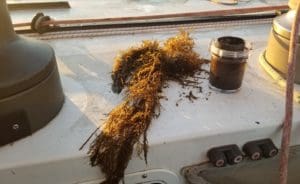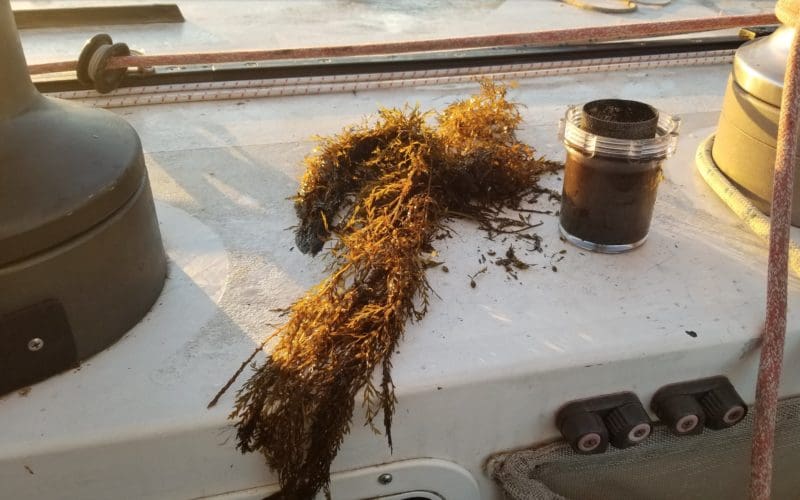 By Rob MacFarlane
By Rob MacFarlane
A raw-water cooled engine draws in sea water from the ocean, pumps it through the motor or heat exchanger to extract heat, then returns the water overboard. On my boat, the cooling water is combined with engine exhaust gases through the exhaust elbow and wet-exhaust line. An issue with using sea water is there’s no control of what’s in the sea water being pumped in — all sorts of detritus can be included, including small fish, sea weed, debris, bits and pieces. The engine cooling system’s first line of defense is the lowly sea water strainer — essentially a metal mesh screen in a can that is cut into the inlet hose. The entire purpose of the strainer is to prevent passage through of debris large enough to damage the raw water pump’s impeller or block a passage in the heat exchanger.
After starting the engine the first thing I do is verify that water is flowing out the exhaust line. On my boat this is a fairly obvious. The exhaust skin fitting is at the transom, well above the water line, and a lot of water is pumped out which makes a noticeable splashing sound. When water pumps out I know the through-hull is open, the sea strainer is clear, and the raw water pump impeller is working. While powering along I listen for the splashing sound — I relax when I hear it.
If the splashing sound stops that’s not a good sign. I’ll pop aft for a look and if the only thing exiting the exhaust is exhaust smoke there’s a problem; at that point I immediately shut down the motor and start troubleshooting.
On a recent run the raw water pump managed to suck up a mass of seaweed — this immediately blocked the sea strainer. Fortunately the problem was noted within seconds as I had just departed the anchorage. I turned the motor off, unfurled the jib to point the boat away from shore and dove into the exhaust system to sort out what was going on.
When troubleshooting, start at the beginning. For example, verify that the through-hull is open. If so, go to the sea strainer and open it up. If water gushes forth into the boat then you know there’s not a problem there. If no water appears, you’ve found the culprit.
In my case it was actually two culprits: the sea strainer was entirely packed with a dense fine brown seaweed, but removal of the strainer did not result in water pouring into the boat. Turns out there was another couple feet of seaweed packed into the intake hose leading to the sea strainer. It took a bit to remove with the help of a hemostat and a long reach grabber.
Once I had water flowing in again I closed the through-hull and moved on to the motor — it’s important to verify that the rubber impeller inside the raw water pump had not overheated (due to no water and therefore no cooling and lubrication); if that happens the impeller can shred itself into little shards that can be sucked further into the cooling system and lodge in the heat exchanger tube stack.
I opened up the raw water pump, extracted the impeller (everyone carries an impeller puller, yes?), verified all the vanes were present, lubed the impeller and reinstalled it.
With everything a “go” I double-checked that the through-hull was open, re-assembled strainer not leaking, raw water pump cover plate not leaking, and fired up the engine. Boom! — instant cooling water cranking out the transom.
My suggestion: know the route of the engine cooling water through your boat, know where the tools are to service that (impeller puller, strainer cover wrench), and have spare parts handy (strainer O-rings, raw water pump O-rings, impellers). And pay attention to the noise the exhaust water makes. If that noise is suddenly silenced go look: that can save the engine from a disastrous over-heating.
Rob MacFarlane has raced and cruised as a singlehander for 30 years on San Francisco Bay, the West Coast, Hawaii, Mexico, Canada and French Polynesia.

